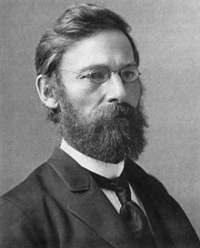Leonhard Stejneger
| Leonhard Hess Stejneger | |
|---|---|
 | |
| Born |
30 October 1851 Bergen, Norway |
| Died |
28 February 1943 (age 91) Washington, D.C. |
| Education | Ph.D., University of Christiania |
| Occupation | biologist |
Leonhard Hess Stejneger (30 October 1851 – 28 February 1943) was a Norwegian-born American ornithologist, herpetologist and zoologist. Stejneger specialized in vertebrate natural history studies. He gained his greatest reputation with reptiles and amphibians.[1]
Early life
Stejneger was born in Bergen, Norway. His father was Peter Stamer Steineger, a merchant and auditor; his mother was Ingeborg Catharine (Hess). He was the eldest of 7 children. Until 1880, the Steineger family had been one of the wealthy families in Bergen; at that time business reverses led to the father's declaring bankruptcy.[2]
Stejneger attended the Smith Theological School in Bergen from 1859–1860, and Bergen Latin School until 1869. His interests in zoology developed early. By age sixteen he had a printed catalogue of birds, and he painted birds in water color. He moved with his mother to Meran in South Tyrol and studied under a private tutor. He studied law and philosophy at the University of Christiania. He earned a Ph.D. and started a brief career as a lawyer.[1]
Career
In 1881 Stejneger moved to the United States, becoming a citizen in 1887. He started working at the Smithsonian Institution under Spencer Fullerton Baird. Stejneger participated in numerous expeditions to the northern parts of the North American continent. From 1882 to 1883 he was on an exploration mission to Bering Island and Kamchatka. In 1895 he went to the Commander Islands, studying fur seals for the U.S. Fish Commission. He returned there a second time in 1922.[3]
Within the Smithsonian Institution, he moved up the career ladder. In 1884 he was Assistant Curator for birds, in 1889 Curator for reptiles, in 1899 Curator for reptiles and amphibians, and from 1911 on Head Curator for biology, a post he held until his death, having been exempted from retirement by a presidential decree.
Stejneger published more than 400 scientific works on birds, reptiles, seals, the herpetology of Puerto Rico, and other topics.
During his Bering Island trip he became fascinated by the life of Georg Wilhelm Steller, an 18th-century naturalist who had previously visited there. He thoroughly researched Steller's life over the next few decades, a hobby which culminated in his only non-scientific publication, an authoritative Steller biography.[4]
Stejneger was a Life Member of the Bergen Museum. He attended the International Congresses of Zoology of 1898, 1901, 1904, 1907, 1913, 1927, and 1930, as well as ornithological and fisheries congresses. He was elected to the International Committee on Zoological Nomenclature in 1898 and served as the organizing secretary for the Section on Zoogeography at the 1907 International Zoological Congress (VII) in Boston. In 1900 he was awarded a gold medal at the Paris Exposition for his work on fur seals management and conservation. In 1923 Stejneger was elected to the National Academy of Sciences. In 1931 he was made honorary president for life of the American Society of Ichthyologists and Herpetologists. In 1939 he was made a Commander of the Royal Norwegian Order of St. Olaf.[5]
Selected bibliography
- Results of Ornithological Explorations in the Commander Islands and in Kamtschatka (1885)
- Birds of Kauai Island, Hawaiian Archipelago / collected by Mr. Valdemar Knudsen, with description of new species (1887)
- Notes on a third collection of birds made in Kauai, Hawaiian Islands (1890)
- The Poisonous Snakes of North America (1895)
- The Russian Fur-Seal Islands (1896)
- Herpetology of Porto Rico (1904)
- Herpetology of Japan and Adjacent Territories (1907)
- A new Gerrhonotine Lizard from Costa Rica (1907)
- Three new species of lizards from the Philippine Islands (1908)
- A new genus and species of lizard from Florida (1911)
- A new Scincid Lizard from the Philippine Islands (1911)
- Results of the Yale Peruvian Expedition of 1911. Batrachians and Reptiles (1913)
- A Check List of North American Amphibians and Reptiles [with Thomas Barbour] (1917)
- A chapter in the history of zoological nomenclature (1924)
- Fur-seal industry of the Commander Islands: 1897-1922 (1925)
- Identity of Hallowell's snake genera, Megalops and Aepidea (1927)
- The Chinese lizards of the genus Gekko (1934)
- Georg Wilhelm Steller, the pioneer of Alaskan natural history (1936)
References
- 1 2 Wetmore, Alexander (1945) Leonhard Hess Stejneger (1851-1943). Biographical Memoir. Nat. Acad. Sci. Vol. 24. PDF
- ↑ Leonhard Hess Stejneger (Store norske leksikon)
- ↑ Leonhard Stejneger – utdypning (Gunnar Langhelle. Store norske leksikon)
- ↑ Cronologia Ornitologica (National Academy Biographical Memoirs, Vol. XXIV)
- ↑ Stejneger, Leonhard Hess (Norway-United States 1851-1943) (Chrono-Biographical Sketches: Some Biographers, Evolutionists and Ecologists)
External links
- Works by or about Leonhard Stejneger at Internet Archive
- Leonhard Stejneger Papers, 1867-1943 (by William R. Massa, Jr., and Linda Elmore. Smithsonian Institution Archives)
- Leonhard Hess Stejneger 1851-1943 (by Alexander Wetmore. Presented to the National Academy of Sciences of the United States of America at the Autumn Meeting. 1945)
- Leonhard Stejneger (by Thomas Barbour. The Auk, v. 61, no. 2, April 1944, p. 201-203)
- Leonhard Stejneger (by Waldo Schmitt. Systematic Zoology, v. 13, no. 4, 1964, p. 243-249)
- Leonhard Stejneger Field Photographs